The Investment of Advertising Impacts on Consumer Purchase Intention
VerifiedAdded on 2020/06/04
|41
|11045
|251
Report
AI Summary
This report presents an empirical study on the impact of advertising investments on consumer purchase intention, specifically within the consumer goods industry in Thailand. The research explores the relationship between advertising expenditure and sales volume, examining the effectiveness of various media channels. The study addresses several key research questions, including whether advertising impacts sales volume, if increased spending leads to higher sales, and which media channels are most effective. The report provides a literature review that defines advertising and explores its impact on consumer behavior. The methodology involves a correlation study using secondary data from the Nielsen Corporation and the Stock Exchange of Thailand, focusing on 50 consumer goods companies. The study aims to provide insights for marketing managers to optimize advertising budgets and communication strategies.
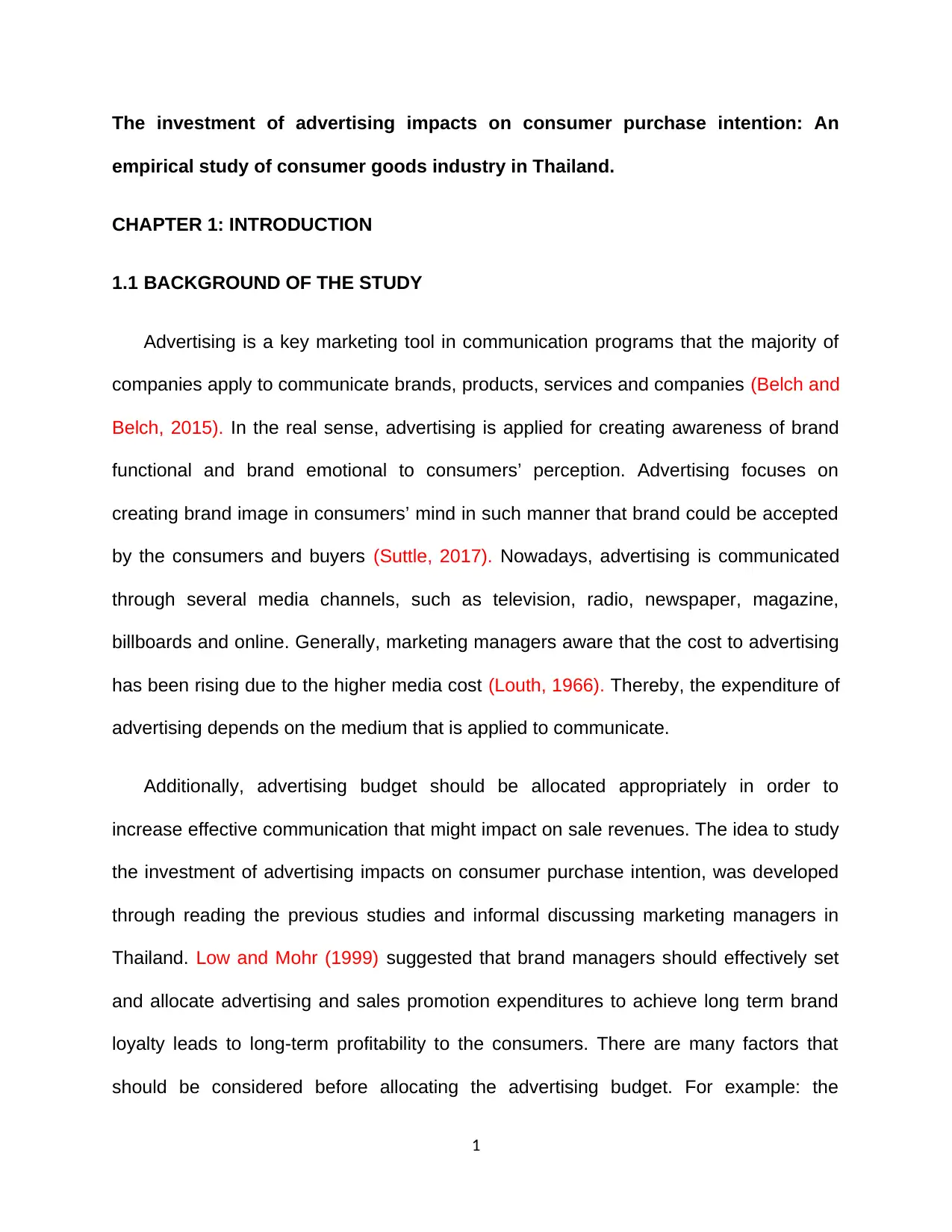
The investment of advertising impacts on consumer purchase intention: An
empirical study of consumer goods industry in Thailand.
CHAPTER 1: INTRODUCTION
1.1 BACKGROUND OF THE STUDY
Advertising is a key marketing tool in communication programs that the majority of
companies apply to communicate brands, products, services and companies (Belch and
Belch, 2015). In the real sense, advertising is applied for creating awareness of brand
functional and brand emotional to consumers’ perception. Advertising focuses on
creating brand image in consumers’ mind in such manner that brand could be accepted
by the consumers and buyers (Suttle, 2017). Nowadays, advertising is communicated
through several media channels, such as television, radio, newspaper, magazine,
billboards and online. Generally, marketing managers aware that the cost to advertising
has been rising due to the higher media cost (Louth, 1966). Thereby, the expenditure of
advertising depends on the medium that is applied to communicate.
Additionally, advertising budget should be allocated appropriately in order to
increase effective communication that might impact on sale revenues. The idea to study
the investment of advertising impacts on consumer purchase intention, was developed
through reading the previous studies and informal discussing marketing managers in
Thailand. Low and Mohr (1999) suggested that brand managers should effectively set
and allocate advertising and sales promotion expenditures to achieve long term brand
loyalty leads to long-term profitability to the consumers. There are many factors that
should be considered before allocating the advertising budget. For example: the
1
empirical study of consumer goods industry in Thailand.
CHAPTER 1: INTRODUCTION
1.1 BACKGROUND OF THE STUDY
Advertising is a key marketing tool in communication programs that the majority of
companies apply to communicate brands, products, services and companies (Belch and
Belch, 2015). In the real sense, advertising is applied for creating awareness of brand
functional and brand emotional to consumers’ perception. Advertising focuses on
creating brand image in consumers’ mind in such manner that brand could be accepted
by the consumers and buyers (Suttle, 2017). Nowadays, advertising is communicated
through several media channels, such as television, radio, newspaper, magazine,
billboards and online. Generally, marketing managers aware that the cost to advertising
has been rising due to the higher media cost (Louth, 1966). Thereby, the expenditure of
advertising depends on the medium that is applied to communicate.
Additionally, advertising budget should be allocated appropriately in order to
increase effective communication that might impact on sale revenues. The idea to study
the investment of advertising impacts on consumer purchase intention, was developed
through reading the previous studies and informal discussing marketing managers in
Thailand. Low and Mohr (1999) suggested that brand managers should effectively set
and allocate advertising and sales promotion expenditures to achieve long term brand
loyalty leads to long-term profitability to the consumers. There are many factors that
should be considered before allocating the advertising budget. For example: the
1
Paraphrase This Document
Need a fresh take? Get an instant paraphrase of this document with our AI Paraphraser
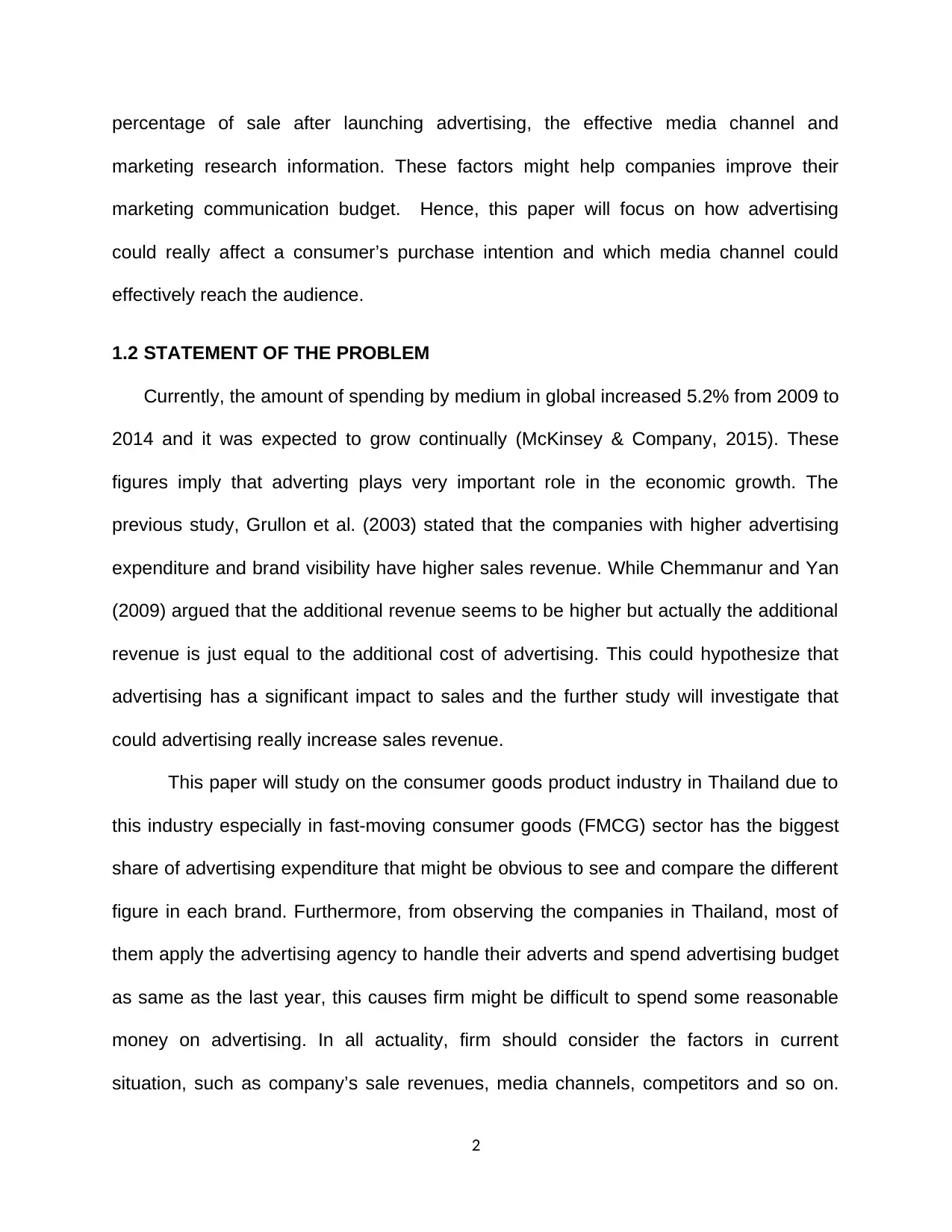
percentage of sale after launching advertising, the effective media channel and
marketing research information. These factors might help companies improve their
marketing communication budget. Hence, this paper will focus on how advertising
could really affect a consumer’s purchase intention and which media channel could
effectively reach the audience.
1.2 STATEMENT OF THE PROBLEM
Currently, the amount of spending by medium in global increased 5.2% from 2009 to
2014 and it was expected to grow continually (McKinsey & Company, 2015). These
figures imply that adverting plays very important role in the economic growth. The
previous study, Grullon et al. (2003) stated that the companies with higher advertising
expenditure and brand visibility have higher sales revenue. While Chemmanur and Yan
(2009) argued that the additional revenue seems to be higher but actually the additional
revenue is just equal to the additional cost of advertising. This could hypothesize that
advertising has a significant impact to sales and the further study will investigate that
could advertising really increase sales revenue.
This paper will study on the consumer goods product industry in Thailand due to
this industry especially in fast-moving consumer goods (FMCG) sector has the biggest
share of advertising expenditure that might be obvious to see and compare the different
figure in each brand. Furthermore, from observing the companies in Thailand, most of
them apply the advertising agency to handle their adverts and spend advertising budget
as same as the last year, this causes firm might be difficult to spend some reasonable
money on advertising. In all actuality, firm should consider the factors in current
situation, such as company’s sale revenues, media channels, competitors and so on.
2
marketing research information. These factors might help companies improve their
marketing communication budget. Hence, this paper will focus on how advertising
could really affect a consumer’s purchase intention and which media channel could
effectively reach the audience.
1.2 STATEMENT OF THE PROBLEM
Currently, the amount of spending by medium in global increased 5.2% from 2009 to
2014 and it was expected to grow continually (McKinsey & Company, 2015). These
figures imply that adverting plays very important role in the economic growth. The
previous study, Grullon et al. (2003) stated that the companies with higher advertising
expenditure and brand visibility have higher sales revenue. While Chemmanur and Yan
(2009) argued that the additional revenue seems to be higher but actually the additional
revenue is just equal to the additional cost of advertising. This could hypothesize that
advertising has a significant impact to sales and the further study will investigate that
could advertising really increase sales revenue.
This paper will study on the consumer goods product industry in Thailand due to
this industry especially in fast-moving consumer goods (FMCG) sector has the biggest
share of advertising expenditure that might be obvious to see and compare the different
figure in each brand. Furthermore, from observing the companies in Thailand, most of
them apply the advertising agency to handle their adverts and spend advertising budget
as same as the last year, this causes firm might be difficult to spend some reasonable
money on advertising. In all actuality, firm should consider the factors in current
situation, such as company’s sale revenues, media channels, competitors and so on.
2
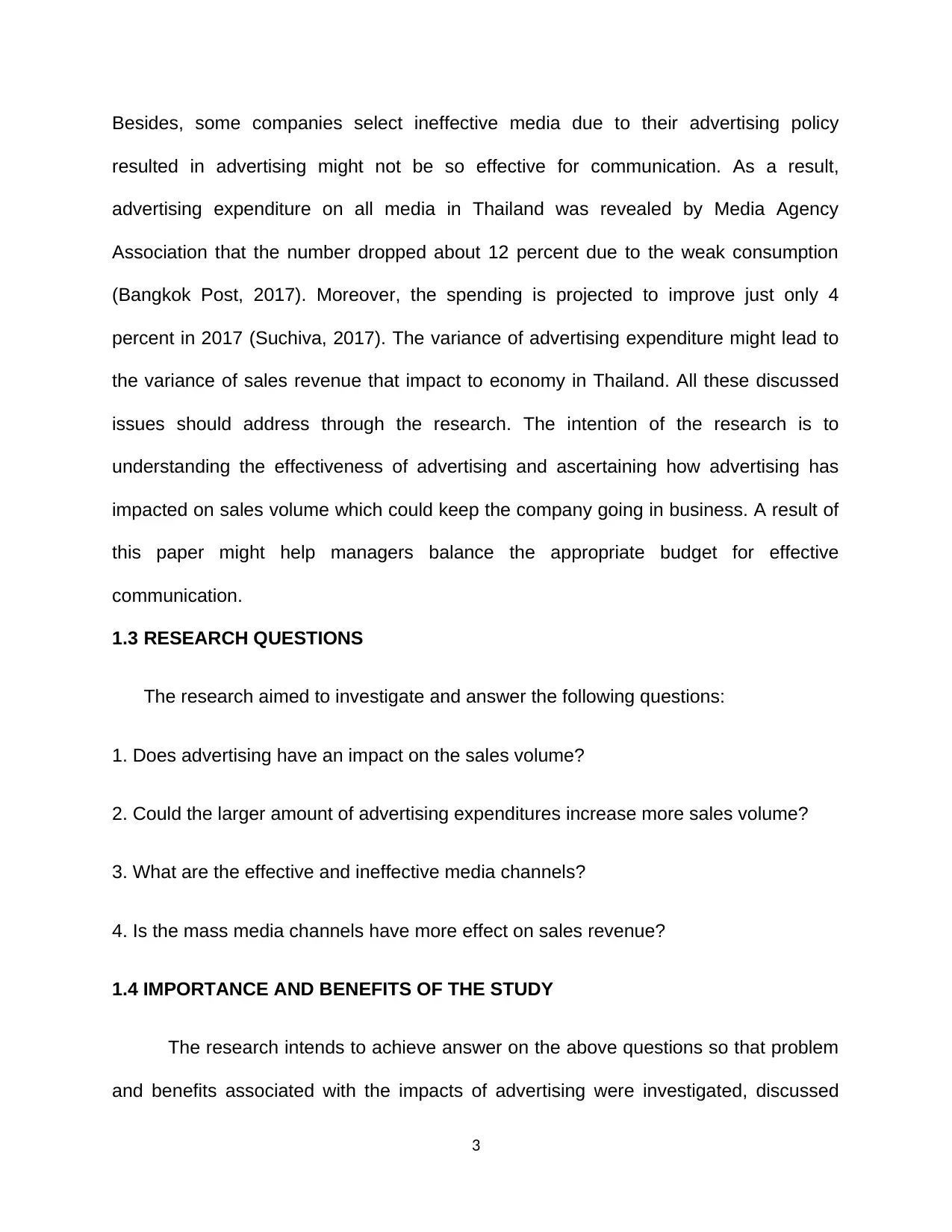
Besides, some companies select ineffective media due to their advertising policy
resulted in advertising might not be so effective for communication. As a result,
advertising expenditure on all media in Thailand was revealed by Media Agency
Association that the number dropped about 12 percent due to the weak consumption
(Bangkok Post, 2017). Moreover, the spending is projected to improve just only 4
percent in 2017 (Suchiva, 2017). The variance of advertising expenditure might lead to
the variance of sales revenue that impact to economy in Thailand. All these discussed
issues should address through the research. The intention of the research is to
understanding the effectiveness of advertising and ascertaining how advertising has
impacted on sales volume which could keep the company going in business. A result of
this paper might help managers balance the appropriate budget for effective
communication.
1.3 RESEARCH QUESTIONS
The research aimed to investigate and answer the following questions:
1. Does advertising have an impact on the sales volume?
2. Could the larger amount of advertising expenditures increase more sales volume?
3. What are the effective and ineffective media channels?
4. Is the mass media channels have more effect on sales revenue?
1.4 IMPORTANCE AND BENEFITS OF THE STUDY
The research intends to achieve answer on the above questions so that problem
and benefits associated with the impacts of advertising were investigated, discussed
3
resulted in advertising might not be so effective for communication. As a result,
advertising expenditure on all media in Thailand was revealed by Media Agency
Association that the number dropped about 12 percent due to the weak consumption
(Bangkok Post, 2017). Moreover, the spending is projected to improve just only 4
percent in 2017 (Suchiva, 2017). The variance of advertising expenditure might lead to
the variance of sales revenue that impact to economy in Thailand. All these discussed
issues should address through the research. The intention of the research is to
understanding the effectiveness of advertising and ascertaining how advertising has
impacted on sales volume which could keep the company going in business. A result of
this paper might help managers balance the appropriate budget for effective
communication.
1.3 RESEARCH QUESTIONS
The research aimed to investigate and answer the following questions:
1. Does advertising have an impact on the sales volume?
2. Could the larger amount of advertising expenditures increase more sales volume?
3. What are the effective and ineffective media channels?
4. Is the mass media channels have more effect on sales revenue?
1.4 IMPORTANCE AND BENEFITS OF THE STUDY
The research intends to achieve answer on the above questions so that problem
and benefits associated with the impacts of advertising were investigated, discussed
3
⊘ This is a preview!⊘
Do you want full access?
Subscribe today to unlock all pages.

Trusted by 1+ million students worldwide
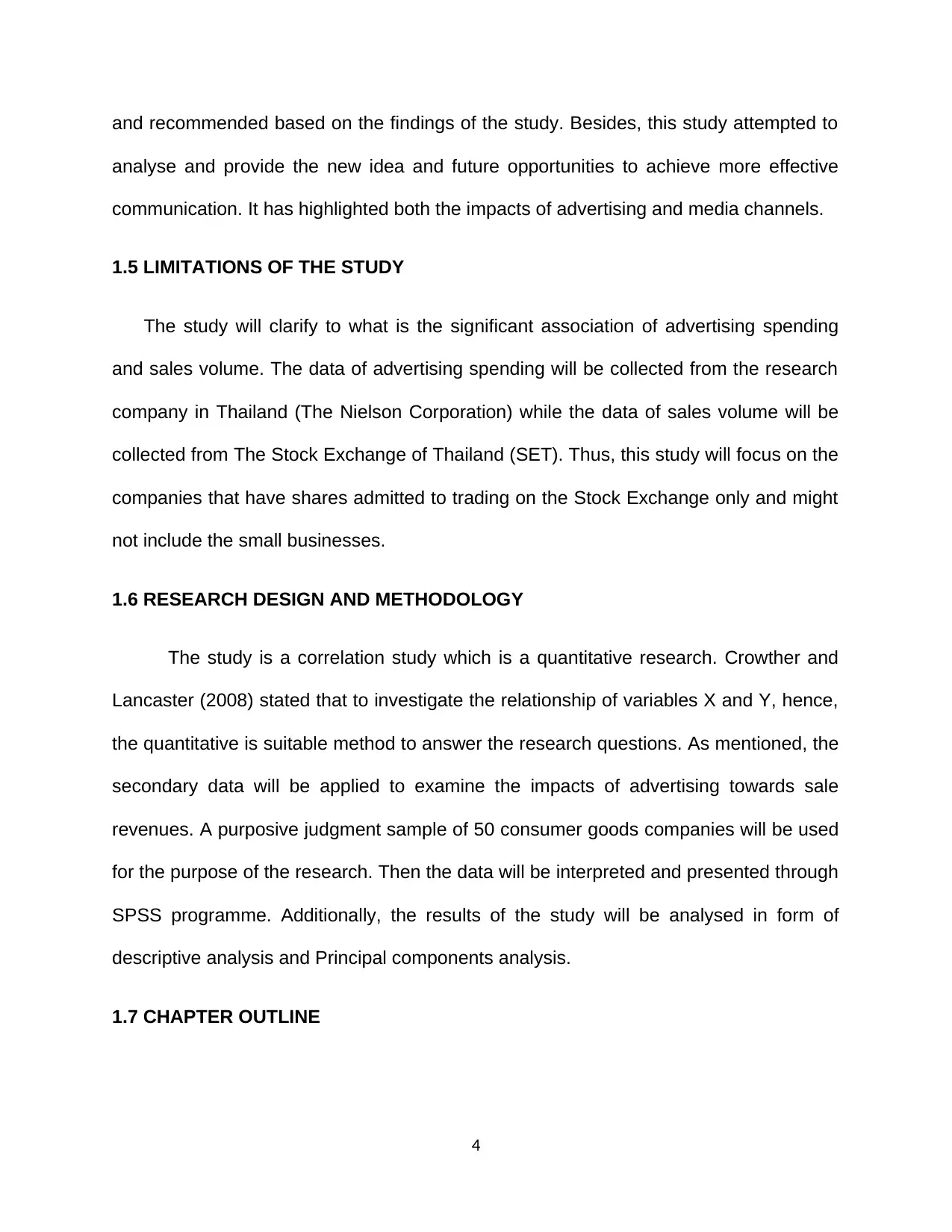
and recommended based on the findings of the study. Besides, this study attempted to
analyse and provide the new idea and future opportunities to achieve more effective
communication. It has highlighted both the impacts of advertising and media channels.
1.5 LIMITATIONS OF THE STUDY
The study will clarify to what is the significant association of advertising spending
and sales volume. The data of advertising spending will be collected from the research
company in Thailand (The Nielson Corporation) while the data of sales volume will be
collected from The Stock Exchange of Thailand (SET). Thus, this study will focus on the
companies that have shares admitted to trading on the Stock Exchange only and might
not include the small businesses.
1.6 RESEARCH DESIGN AND METHODOLOGY
The study is a correlation study which is a quantitative research. Crowther and
Lancaster (2008) stated that to investigate the relationship of variables X and Y, hence,
the quantitative is suitable method to answer the research questions. As mentioned, the
secondary data will be applied to examine the impacts of advertising towards sale
revenues. A purposive judgment sample of 50 consumer goods companies will be used
for the purpose of the research. Then the data will be interpreted and presented through
SPSS programme. Additionally, the results of the study will be analysed in form of
descriptive analysis and Principal components analysis.
1.7 CHAPTER OUTLINE
4
analyse and provide the new idea and future opportunities to achieve more effective
communication. It has highlighted both the impacts of advertising and media channels.
1.5 LIMITATIONS OF THE STUDY
The study will clarify to what is the significant association of advertising spending
and sales volume. The data of advertising spending will be collected from the research
company in Thailand (The Nielson Corporation) while the data of sales volume will be
collected from The Stock Exchange of Thailand (SET). Thus, this study will focus on the
companies that have shares admitted to trading on the Stock Exchange only and might
not include the small businesses.
1.6 RESEARCH DESIGN AND METHODOLOGY
The study is a correlation study which is a quantitative research. Crowther and
Lancaster (2008) stated that to investigate the relationship of variables X and Y, hence,
the quantitative is suitable method to answer the research questions. As mentioned, the
secondary data will be applied to examine the impacts of advertising towards sale
revenues. A purposive judgment sample of 50 consumer goods companies will be used
for the purpose of the research. Then the data will be interpreted and presented through
SPSS programme. Additionally, the results of the study will be analysed in form of
descriptive analysis and Principal components analysis.
1.7 CHAPTER OUTLINE
4
Paraphrase This Document
Need a fresh take? Get an instant paraphrase of this document with our AI Paraphraser
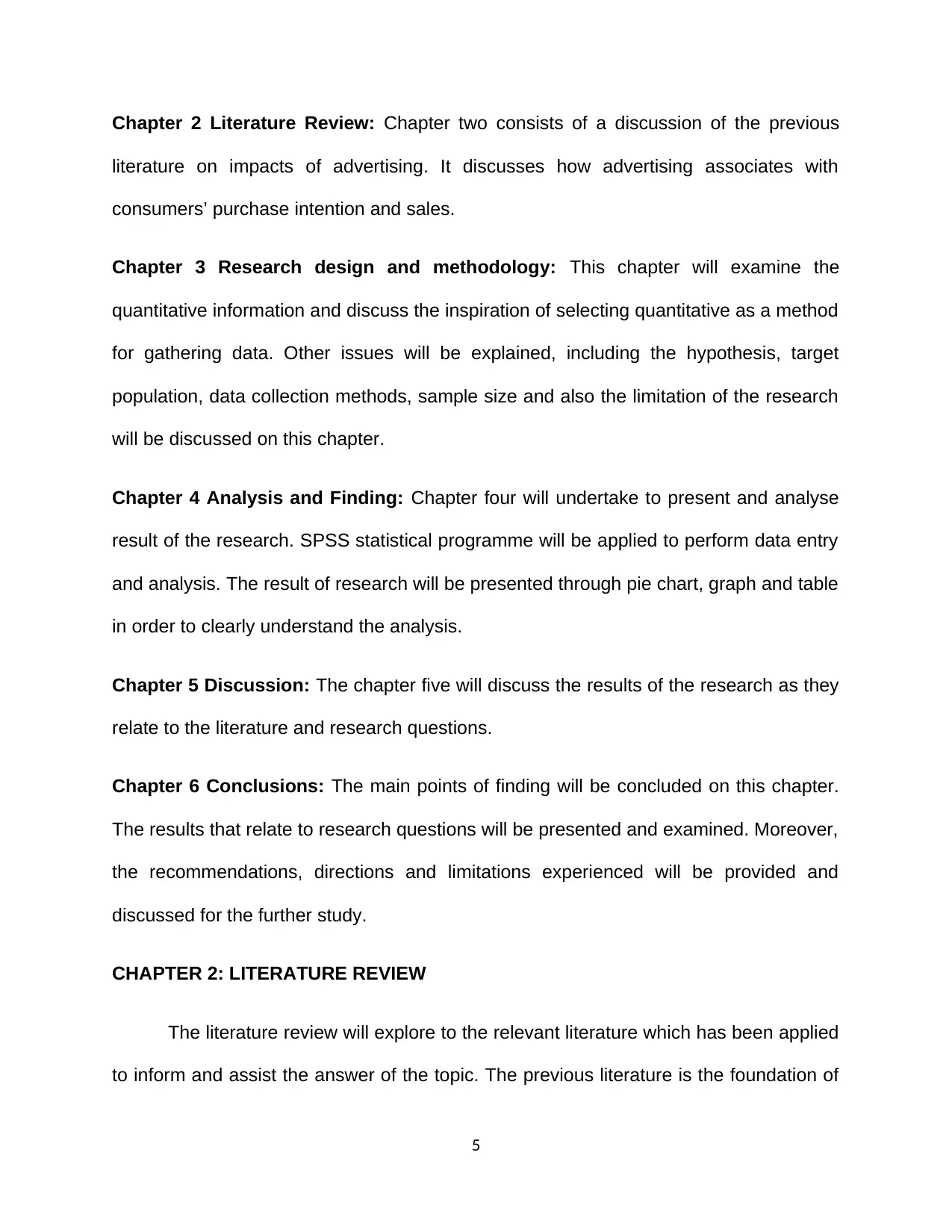
Chapter 2 Literature Review: Chapter two consists of a discussion of the previous
literature on impacts of advertising. It discusses how advertising associates with
consumers’ purchase intention and sales.
Chapter 3 Research design and methodology: This chapter will examine the
quantitative information and discuss the inspiration of selecting quantitative as a method
for gathering data. Other issues will be explained, including the hypothesis, target
population, data collection methods, sample size and also the limitation of the research
will be discussed on this chapter.
Chapter 4 Analysis and Finding: Chapter four will undertake to present and analyse
result of the research. SPSS statistical programme will be applied to perform data entry
and analysis. The result of research will be presented through pie chart, graph and table
in order to clearly understand the analysis.
Chapter 5 Discussion: The chapter five will discuss the results of the research as they
relate to the literature and research questions.
Chapter 6 Conclusions: The main points of finding will be concluded on this chapter.
The results that relate to research questions will be presented and examined. Moreover,
the recommendations, directions and limitations experienced will be provided and
discussed for the further study.
CHAPTER 2: LITERATURE REVIEW
The literature review will explore to the relevant literature which has been applied
to inform and assist the answer of the topic. The previous literature is the foundation of
5
literature on impacts of advertising. It discusses how advertising associates with
consumers’ purchase intention and sales.
Chapter 3 Research design and methodology: This chapter will examine the
quantitative information and discuss the inspiration of selecting quantitative as a method
for gathering data. Other issues will be explained, including the hypothesis, target
population, data collection methods, sample size and also the limitation of the research
will be discussed on this chapter.
Chapter 4 Analysis and Finding: Chapter four will undertake to present and analyse
result of the research. SPSS statistical programme will be applied to perform data entry
and analysis. The result of research will be presented through pie chart, graph and table
in order to clearly understand the analysis.
Chapter 5 Discussion: The chapter five will discuss the results of the research as they
relate to the literature and research questions.
Chapter 6 Conclusions: The main points of finding will be concluded on this chapter.
The results that relate to research questions will be presented and examined. Moreover,
the recommendations, directions and limitations experienced will be provided and
discussed for the further study.
CHAPTER 2: LITERATURE REVIEW
The literature review will explore to the relevant literature which has been applied
to inform and assist the answer of the topic. The previous literature is the foundation of
5
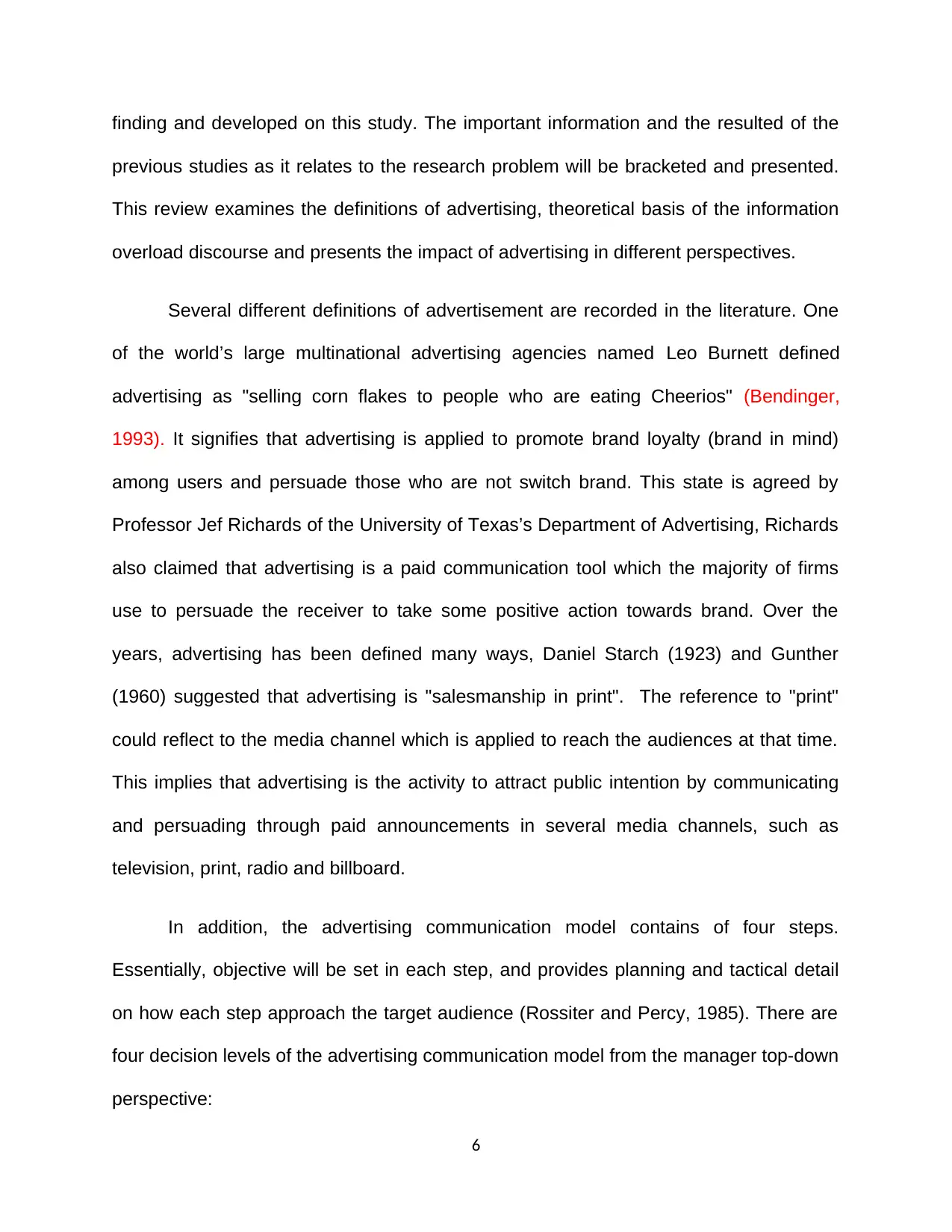
finding and developed on this study. The important information and the resulted of the
previous studies as it relates to the research problem will be bracketed and presented.
This review examines the definitions of advertising, theoretical basis of the information
overload discourse and presents the impact of advertising in different perspectives.
Several different definitions of advertisement are recorded in the literature. One
of the world’s large multinational advertising agencies named Leo Burnett defined
advertising as "selling corn flakes to people who are eating Cheerios" (Bendinger,
1993). It signifies that advertising is applied to promote brand loyalty (brand in mind)
among users and persuade those who are not switch brand. This state is agreed by
Professor Jef Richards of the University of Texas’s Department of Advertising, Richards
also claimed that advertising is a paid communication tool which the majority of firms
use to persuade the receiver to take some positive action towards brand. Over the
years, advertising has been defined many ways, Daniel Starch (1923) and Gunther
(1960) suggested that advertising is "salesmanship in print". The reference to "print"
could reflect to the media channel which is applied to reach the audiences at that time.
This implies that advertising is the activity to attract public intention by communicating
and persuading through paid announcements in several media channels, such as
television, print, radio and billboard.
In addition, the advertising communication model contains of four steps.
Essentially, objective will be set in each step, and provides planning and tactical detail
on how each step approach the target audience (Rossiter and Percy, 1985). There are
four decision levels of the advertising communication model from the manager top-down
perspective:
6
previous studies as it relates to the research problem will be bracketed and presented.
This review examines the definitions of advertising, theoretical basis of the information
overload discourse and presents the impact of advertising in different perspectives.
Several different definitions of advertisement are recorded in the literature. One
of the world’s large multinational advertising agencies named Leo Burnett defined
advertising as "selling corn flakes to people who are eating Cheerios" (Bendinger,
1993). It signifies that advertising is applied to promote brand loyalty (brand in mind)
among users and persuade those who are not switch brand. This state is agreed by
Professor Jef Richards of the University of Texas’s Department of Advertising, Richards
also claimed that advertising is a paid communication tool which the majority of firms
use to persuade the receiver to take some positive action towards brand. Over the
years, advertising has been defined many ways, Daniel Starch (1923) and Gunther
(1960) suggested that advertising is "salesmanship in print". The reference to "print"
could reflect to the media channel which is applied to reach the audiences at that time.
This implies that advertising is the activity to attract public intention by communicating
and persuading through paid announcements in several media channels, such as
television, print, radio and billboard.
In addition, the advertising communication model contains of four steps.
Essentially, objective will be set in each step, and provides planning and tactical detail
on how each step approach the target audience (Rossiter and Percy, 1985). There are
four decision levels of the advertising communication model from the manager top-down
perspective:
6
⊘ This is a preview!⊘
Do you want full access?
Subscribe today to unlock all pages.

Trusted by 1+ million students worldwide
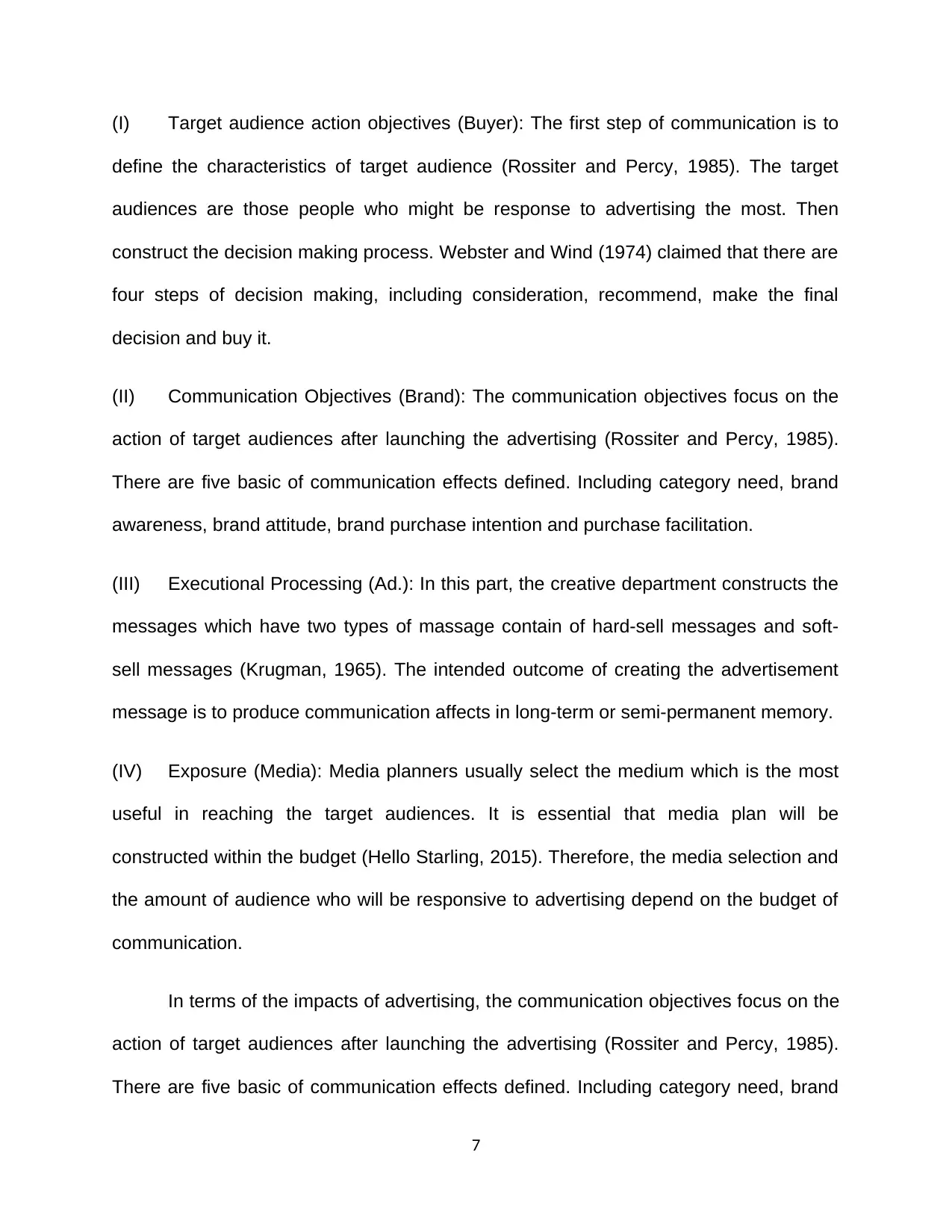
(I) Target audience action objectives (Buyer): The first step of communication is to
define the characteristics of target audience (Rossiter and Percy, 1985). The target
audiences are those people who might be response to advertising the most. Then
construct the decision making process. Webster and Wind (1974) claimed that there are
four steps of decision making, including consideration, recommend, make the final
decision and buy it.
(II) Communication Objectives (Brand): The communication objectives focus on the
action of target audiences after launching the advertising (Rossiter and Percy, 1985).
There are five basic of communication effects defined. Including category need, brand
awareness, brand attitude, brand purchase intention and purchase facilitation.
(III) Executional Processing (Ad.): In this part, the creative department constructs the
messages which have two types of massage contain of hard-sell messages and soft-
sell messages (Krugman, 1965). The intended outcome of creating the advertisement
message is to produce communication affects in long-term or semi-permanent memory.
(IV) Exposure (Media): Media planners usually select the medium which is the most
useful in reaching the target audiences. It is essential that media plan will be
constructed within the budget (Hello Starling, 2015). Therefore, the media selection and
the amount of audience who will be responsive to advertising depend on the budget of
communication.
In terms of the impacts of advertising, the communication objectives focus on the
action of target audiences after launching the advertising (Rossiter and Percy, 1985).
There are five basic of communication effects defined. Including category need, brand
7
define the characteristics of target audience (Rossiter and Percy, 1985). The target
audiences are those people who might be response to advertising the most. Then
construct the decision making process. Webster and Wind (1974) claimed that there are
four steps of decision making, including consideration, recommend, make the final
decision and buy it.
(II) Communication Objectives (Brand): The communication objectives focus on the
action of target audiences after launching the advertising (Rossiter and Percy, 1985).
There are five basic of communication effects defined. Including category need, brand
awareness, brand attitude, brand purchase intention and purchase facilitation.
(III) Executional Processing (Ad.): In this part, the creative department constructs the
messages which have two types of massage contain of hard-sell messages and soft-
sell messages (Krugman, 1965). The intended outcome of creating the advertisement
message is to produce communication affects in long-term or semi-permanent memory.
(IV) Exposure (Media): Media planners usually select the medium which is the most
useful in reaching the target audiences. It is essential that media plan will be
constructed within the budget (Hello Starling, 2015). Therefore, the media selection and
the amount of audience who will be responsive to advertising depend on the budget of
communication.
In terms of the impacts of advertising, the communication objectives focus on the
action of target audiences after launching the advertising (Rossiter and Percy, 1985).
There are five basic of communication effects defined. Including category need, brand
7
Paraphrase This Document
Need a fresh take? Get an instant paraphrase of this document with our AI Paraphraser
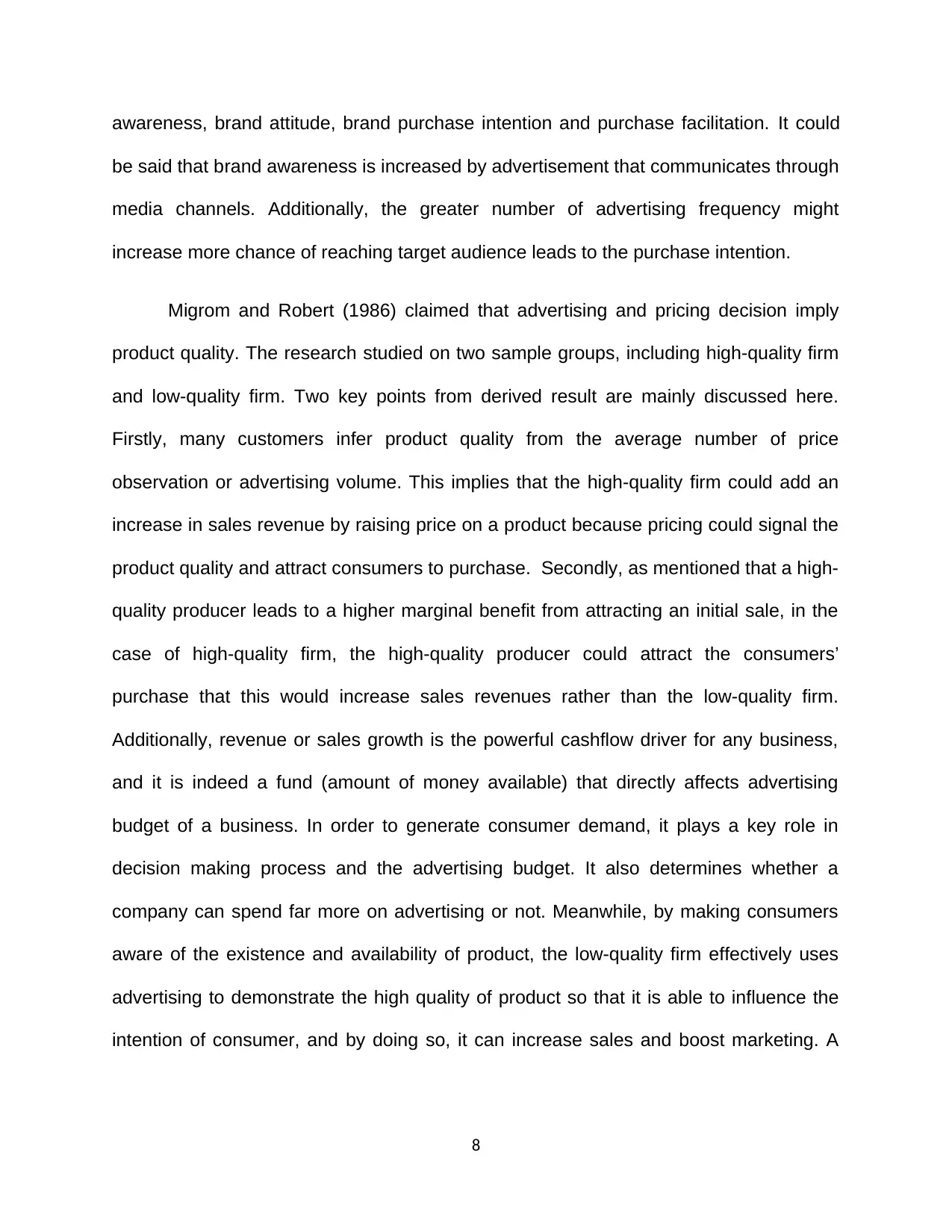
awareness, brand attitude, brand purchase intention and purchase facilitation. It could
be said that brand awareness is increased by advertisement that communicates through
media channels. Additionally, the greater number of advertising frequency might
increase more chance of reaching target audience leads to the purchase intention.
Migrom and Robert (1986) claimed that advertising and pricing decision imply
product quality. The research studied on two sample groups, including high-quality firm
and low-quality firm. Two key points from derived result are mainly discussed here.
Firstly, many customers infer product quality from the average number of price
observation or advertising volume. This implies that the high-quality firm could add an
increase in sales revenue by raising price on a product because pricing could signal the
product quality and attract consumers to purchase. Secondly, as mentioned that a high-
quality producer leads to a higher marginal benefit from attracting an initial sale, in the
case of high-quality firm, the high-quality producer could attract the consumers’
purchase that this would increase sales revenues rather than the low-quality firm.
Additionally, revenue or sales growth is the powerful cashflow driver for any business,
and it is indeed a fund (amount of money available) that directly affects advertising
budget of a business. In order to generate consumer demand, it plays a key role in
decision making process and the advertising budget. It also determines whether a
company can spend far more on advertising or not. Meanwhile, by making consumers
aware of the existence and availability of product, the low-quality firm effectively uses
advertising to demonstrate the high quality of product so that it is able to influence the
intention of consumer, and by doing so, it can increase sales and boost marketing. A
8
be said that brand awareness is increased by advertisement that communicates through
media channels. Additionally, the greater number of advertising frequency might
increase more chance of reaching target audience leads to the purchase intention.
Migrom and Robert (1986) claimed that advertising and pricing decision imply
product quality. The research studied on two sample groups, including high-quality firm
and low-quality firm. Two key points from derived result are mainly discussed here.
Firstly, many customers infer product quality from the average number of price
observation or advertising volume. This implies that the high-quality firm could add an
increase in sales revenue by raising price on a product because pricing could signal the
product quality and attract consumers to purchase. Secondly, as mentioned that a high-
quality producer leads to a higher marginal benefit from attracting an initial sale, in the
case of high-quality firm, the high-quality producer could attract the consumers’
purchase that this would increase sales revenues rather than the low-quality firm.
Additionally, revenue or sales growth is the powerful cashflow driver for any business,
and it is indeed a fund (amount of money available) that directly affects advertising
budget of a business. In order to generate consumer demand, it plays a key role in
decision making process and the advertising budget. It also determines whether a
company can spend far more on advertising or not. Meanwhile, by making consumers
aware of the existence and availability of product, the low-quality firm effectively uses
advertising to demonstrate the high quality of product so that it is able to influence the
intention of consumer, and by doing so, it can increase sales and boost marketing. A
8
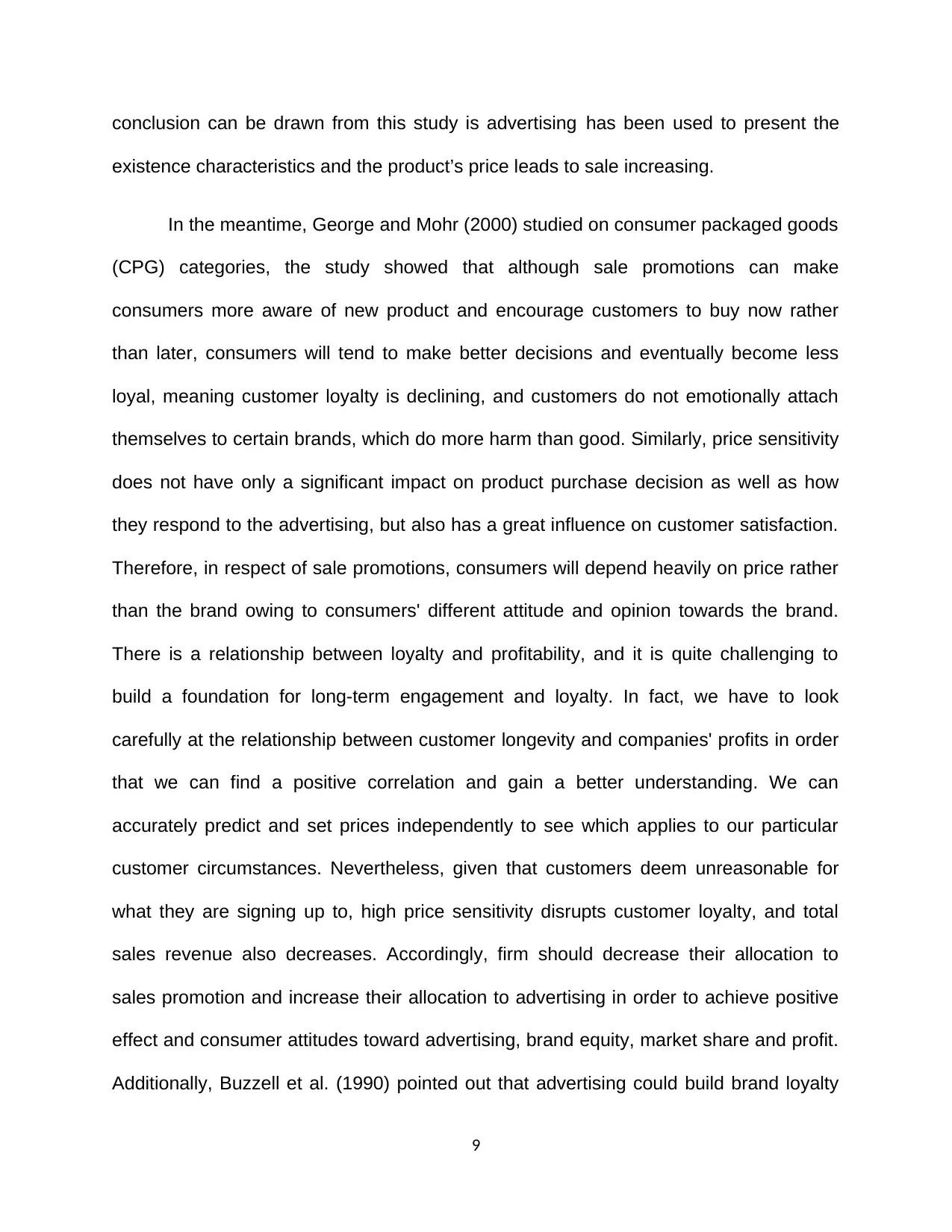
conclusion can be drawn from this study is advertising has been used to present the
existence characteristics and the product’s price leads to sale increasing.
In the meantime, George and Mohr (2000) studied on consumer packaged goods
(CPG) categories, the study showed that although sale promotions can make
consumers more aware of new product and encourage customers to buy now rather
than later, consumers will tend to make better decisions and eventually become less
loyal, meaning customer loyalty is declining, and customers do not emotionally attach
themselves to certain brands, which do more harm than good. Similarly, price sensitivity
does not have only a significant impact on product purchase decision as well as how
they respond to the advertising, but also has a great influence on customer satisfaction.
Therefore, in respect of sale promotions, consumers will depend heavily on price rather
than the brand owing to consumers' different attitude and opinion towards the brand.
There is a relationship between loyalty and profitability, and it is quite challenging to
build a foundation for long-term engagement and loyalty. In fact, we have to look
carefully at the relationship between customer longevity and companies' profits in order
that we can find a positive correlation and gain a better understanding. We can
accurately predict and set prices independently to see which applies to our particular
customer circumstances. Nevertheless, given that customers deem unreasonable for
what they are signing up to, high price sensitivity disrupts customer loyalty, and total
sales revenue also decreases. Accordingly, firm should decrease their allocation to
sales promotion and increase their allocation to advertising in order to achieve positive
effect and consumer attitudes toward advertising, brand equity, market share and profit.
Additionally, Buzzell et al. (1990) pointed out that advertising could build brand loyalty
9
existence characteristics and the product’s price leads to sale increasing.
In the meantime, George and Mohr (2000) studied on consumer packaged goods
(CPG) categories, the study showed that although sale promotions can make
consumers more aware of new product and encourage customers to buy now rather
than later, consumers will tend to make better decisions and eventually become less
loyal, meaning customer loyalty is declining, and customers do not emotionally attach
themselves to certain brands, which do more harm than good. Similarly, price sensitivity
does not have only a significant impact on product purchase decision as well as how
they respond to the advertising, but also has a great influence on customer satisfaction.
Therefore, in respect of sale promotions, consumers will depend heavily on price rather
than the brand owing to consumers' different attitude and opinion towards the brand.
There is a relationship between loyalty and profitability, and it is quite challenging to
build a foundation for long-term engagement and loyalty. In fact, we have to look
carefully at the relationship between customer longevity and companies' profits in order
that we can find a positive correlation and gain a better understanding. We can
accurately predict and set prices independently to see which applies to our particular
customer circumstances. Nevertheless, given that customers deem unreasonable for
what they are signing up to, high price sensitivity disrupts customer loyalty, and total
sales revenue also decreases. Accordingly, firm should decrease their allocation to
sales promotion and increase their allocation to advertising in order to achieve positive
effect and consumer attitudes toward advertising, brand equity, market share and profit.
Additionally, Buzzell et al. (1990) pointed out that advertising could build brand loyalty
9
⊘ This is a preview!⊘
Do you want full access?
Subscribe today to unlock all pages.

Trusted by 1+ million students worldwide
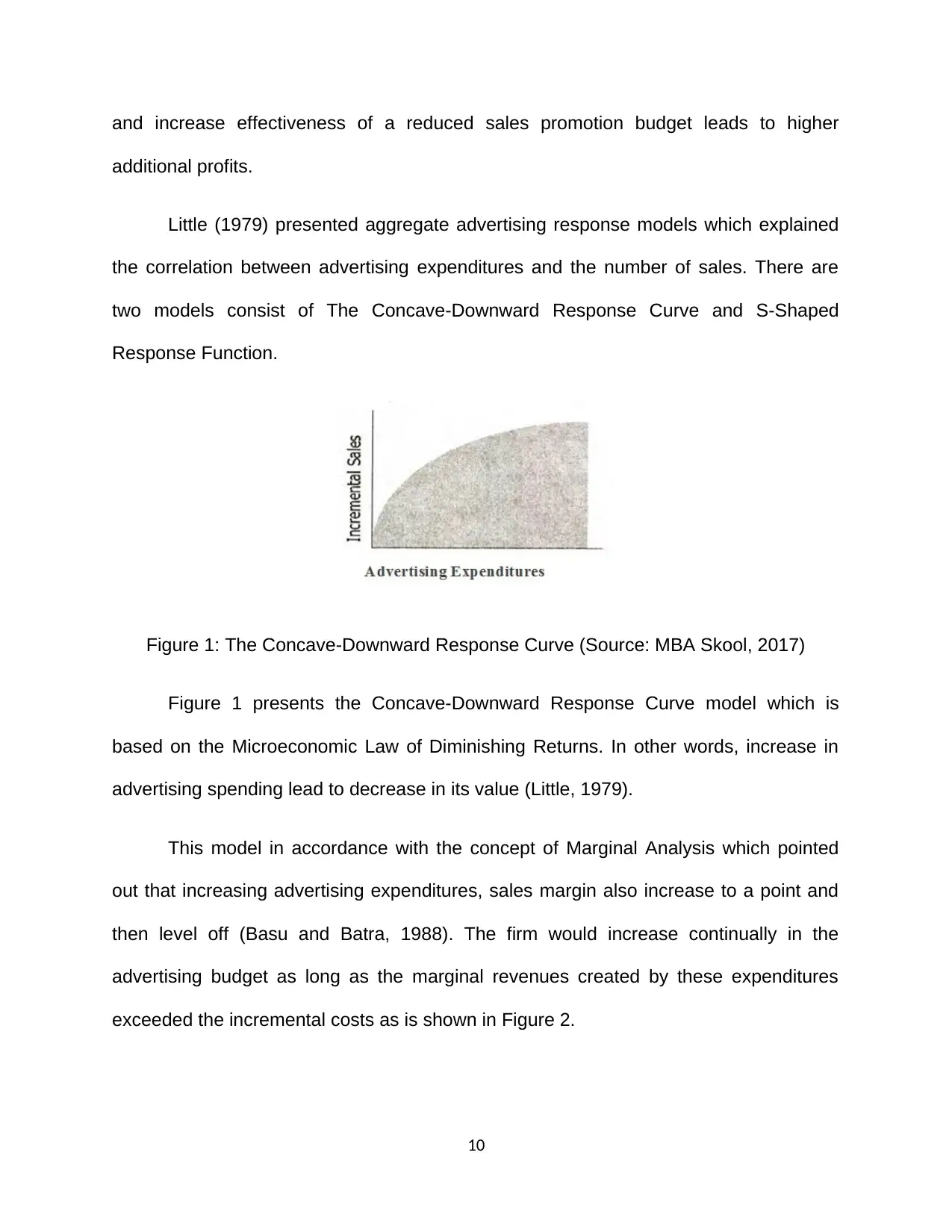
and increase effectiveness of a reduced sales promotion budget leads to higher
additional profits.
Little (1979) presented aggregate advertising response models which explained
the correlation between advertising expenditures and the number of sales. There are
two models consist of The Concave-Downward Response Curve and S-Shaped
Response Function.
Figure 1: The Concave-Downward Response Curve (Source: MBA Skool, 2017)
Figure 1 presents the Concave-Downward Response Curve model which is
based on the Microeconomic Law of Diminishing Returns. In other words, increase in
advertising spending lead to decrease in its value (Little, 1979).
This model in accordance with the concept of Marginal Analysis which pointed
out that increasing advertising expenditures, sales margin also increase to a point and
then level off (Basu and Batra, 1988). The firm would increase continually in the
advertising budget as long as the marginal revenues created by these expenditures
exceeded the incremental costs as is shown in Figure 2.
10
additional profits.
Little (1979) presented aggregate advertising response models which explained
the correlation between advertising expenditures and the number of sales. There are
two models consist of The Concave-Downward Response Curve and S-Shaped
Response Function.
Figure 1: The Concave-Downward Response Curve (Source: MBA Skool, 2017)
Figure 1 presents the Concave-Downward Response Curve model which is
based on the Microeconomic Law of Diminishing Returns. In other words, increase in
advertising spending lead to decrease in its value (Little, 1979).
This model in accordance with the concept of Marginal Analysis which pointed
out that increasing advertising expenditures, sales margin also increase to a point and
then level off (Basu and Batra, 1988). The firm would increase continually in the
advertising budget as long as the marginal revenues created by these expenditures
exceeded the incremental costs as is shown in Figure 2.
10
Paraphrase This Document
Need a fresh take? Get an instant paraphrase of this document with our AI Paraphraser
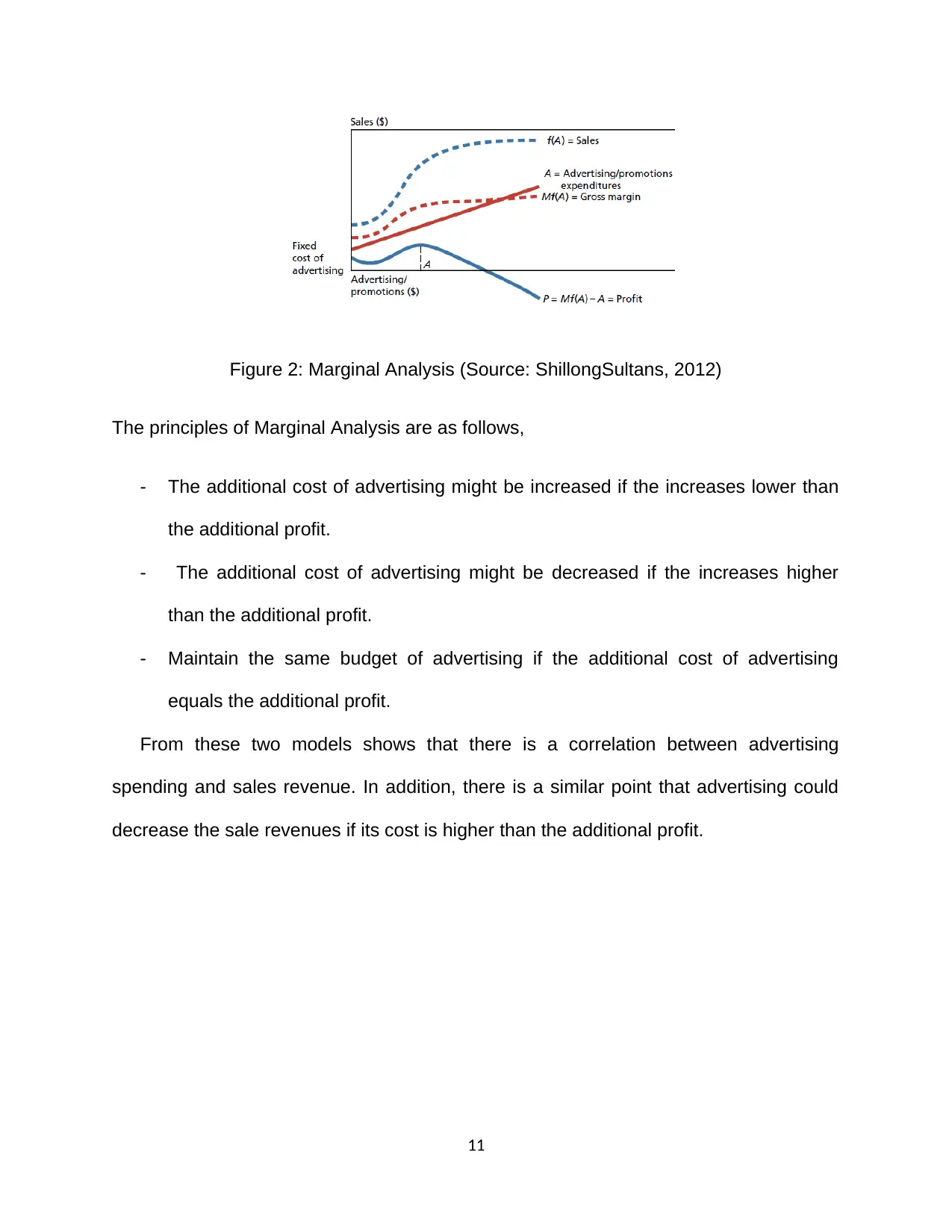
Figure 2: Marginal Analysis (Source: ShillongSultans, 2012)
The principles of Marginal Analysis are as follows,
- The additional cost of advertising might be increased if the increases lower than
the additional profit.
- The additional cost of advertising might be decreased if the increases higher
than the additional profit.
- Maintain the same budget of advertising if the additional cost of advertising
equals the additional profit.
From these two models shows that there is a correlation between advertising
spending and sales revenue. In addition, there is a similar point that advertising could
decrease the sale revenues if its cost is higher than the additional profit.
11
The principles of Marginal Analysis are as follows,
- The additional cost of advertising might be increased if the increases lower than
the additional profit.
- The additional cost of advertising might be decreased if the increases higher
than the additional profit.
- Maintain the same budget of advertising if the additional cost of advertising
equals the additional profit.
From these two models shows that there is a correlation between advertising
spending and sales revenue. In addition, there is a similar point that advertising could
decrease the sale revenues if its cost is higher than the additional profit.
11
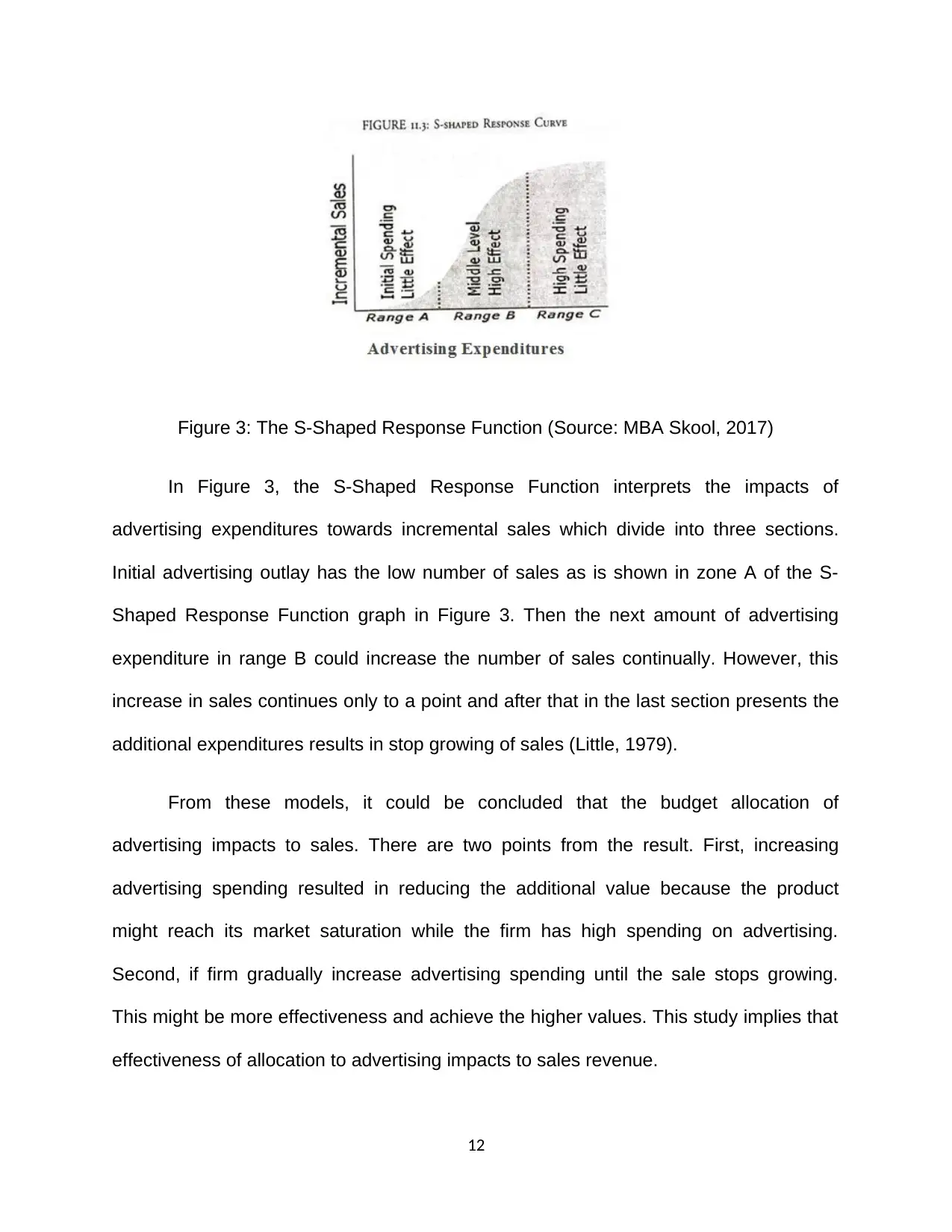
Figure 3: The S-Shaped Response Function (Source: MBA Skool, 2017)
In Figure 3, the S-Shaped Response Function interprets the impacts of
advertising expenditures towards incremental sales which divide into three sections.
Initial advertising outlay has the low number of sales as is shown in zone A of the S-
Shaped Response Function graph in Figure 3. Then the next amount of advertising
expenditure in range B could increase the number of sales continually. However, this
increase in sales continues only to a point and after that in the last section presents the
additional expenditures results in stop growing of sales (Little, 1979).
From these models, it could be concluded that the budget allocation of
advertising impacts to sales. There are two points from the result. First, increasing
advertising spending resulted in reducing the additional value because the product
might reach its market saturation while the firm has high spending on advertising.
Second, if firm gradually increase advertising spending until the sale stops growing.
This might be more effectiveness and achieve the higher values. This study implies that
effectiveness of allocation to advertising impacts to sales revenue.
12
In Figure 3, the S-Shaped Response Function interprets the impacts of
advertising expenditures towards incremental sales which divide into three sections.
Initial advertising outlay has the low number of sales as is shown in zone A of the S-
Shaped Response Function graph in Figure 3. Then the next amount of advertising
expenditure in range B could increase the number of sales continually. However, this
increase in sales continues only to a point and after that in the last section presents the
additional expenditures results in stop growing of sales (Little, 1979).
From these models, it could be concluded that the budget allocation of
advertising impacts to sales. There are two points from the result. First, increasing
advertising spending resulted in reducing the additional value because the product
might reach its market saturation while the firm has high spending on advertising.
Second, if firm gradually increase advertising spending until the sale stops growing.
This might be more effectiveness and achieve the higher values. This study implies that
effectiveness of allocation to advertising impacts to sales revenue.
12
⊘ This is a preview!⊘
Do you want full access?
Subscribe today to unlock all pages.

Trusted by 1+ million students worldwide
1 out of 41
Related Documents
Your All-in-One AI-Powered Toolkit for Academic Success.
+13062052269
info@desklib.com
Available 24*7 on WhatsApp / Email
![[object Object]](/_next/static/media/star-bottom.7253800d.svg)
Unlock your academic potential
Copyright © 2020–2025 A2Z Services. All Rights Reserved. Developed and managed by ZUCOL.




